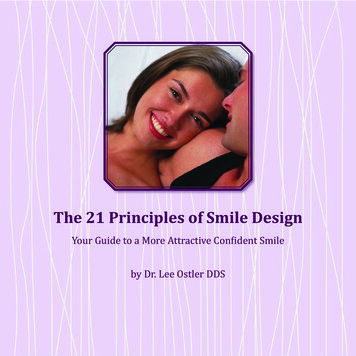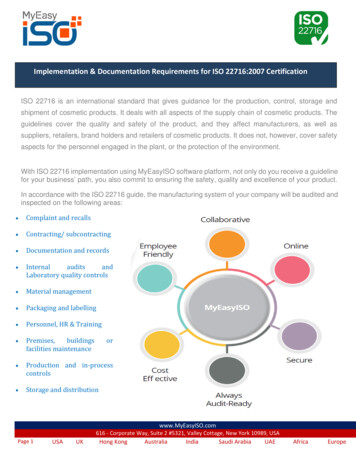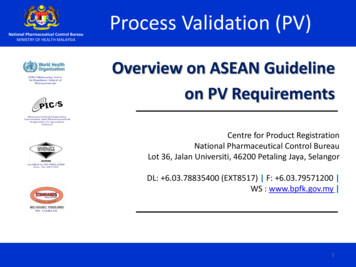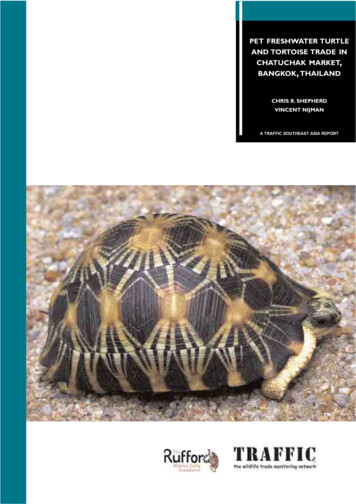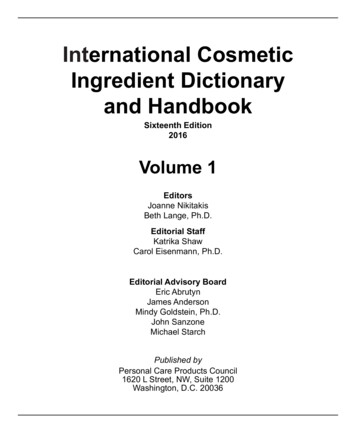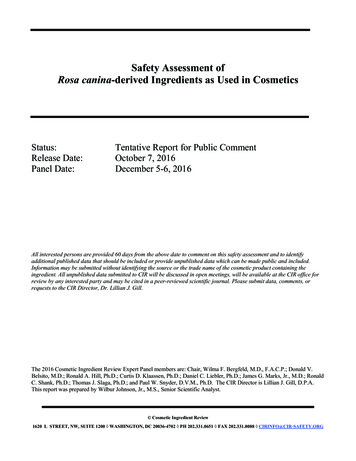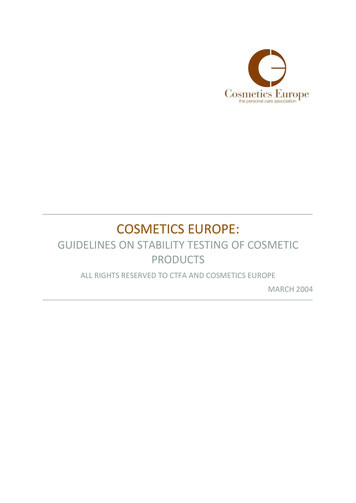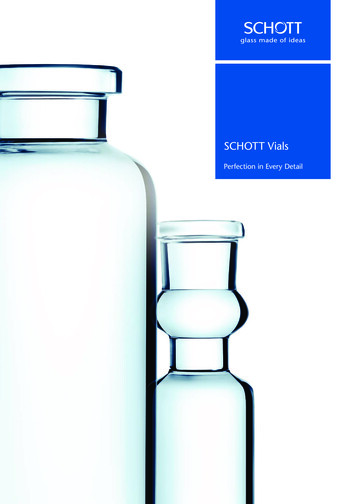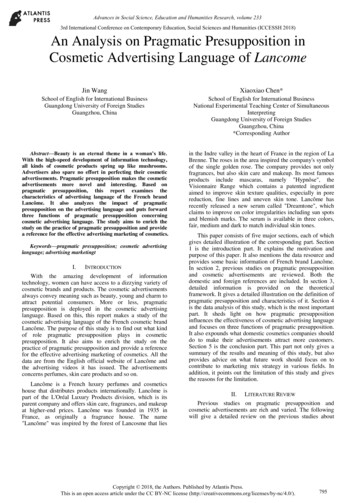
Transcription
ASEAN DEFINITION OF COSMETICS ANDILLUSTRATIVE LIST BY CATEGORY OFCOSMETIC PRODUCTS
Appendix I – Illustrative List of Cosmetic Products by CategoiesAPPENDIX I*ILLUSTRATIVE LIST OF COSMETIC PRODUCTS BY CATEGORIESA.BACKGROUNDThe definition of a cosmetic product which has been adopted by the ACCSQ Product WorkingGroup on Cosmetics is that of the European Directive. In order to understand the thoughtprocesses behind the words it does help to look at the way that the original 1976 definitionwas modified in 1993.Original :Any substance or preparation intended for placing in contact with the externalparts of the human body . or with the teeth and mucous membranes of the oralcavity with a view exclusively or principally to cleaning them1, perfuming them2or protect them3 in order to keep them in good condition4 change theirappearance5 or correct body odour6Current :Any substance or preparation intended to be placed in contact with the externalparts of the human body. or with the teeth and the mucous membranes of theoral cavity with a view exclusively or mainly for cleaning them7, perfumingthem8, changing their appearance9, and/or correcting body odours10 and/orprotecting11 or keeping them in good condition12By removing the words "in order to” and replacing the three functions (1-3) and threeobjectives (4-6) by six individual purposes (7-12) the 1993 definition removes several legalanomalies including the one that effectively excluded all decorative products from beingcosmetics.It should be noted that while the phrase "exclusively or principally" has been changed to"exclusively or mainly" reinforces the fact that the regulators recognise that cosmetic productsmay have functions other than six individually listed.B. ASEAN ILLUSTRATIVE LIST BY CATERGORY OF COSMETIC PRODUCTS APPEARS INATTACHMENT IThis list is not exhaustive and that currently unimagined product forms and types should beconsidered against the definition of a cosmetic and not the list (such as ASEAN uniqueness.)*Number of Appendix and Annex is given for easy referred as stated in the ASEAN agreementon cosmetics
Appendix I Annex I – Illustative List by Categories of Cosmetic ProductsANNEX IILLUSTRATIVE LIST BY CATEGORY OF COSMETIC PRODUCTS-Creams, emulsions, lotions, gels and oils for the skin (hands, face, feet, etc.).-Face masks (with the exception of chemical peeling products).-Tinted bases (liquids. pastes, powders).-Make-up powders, after-bath powders, hygienic powders, etc.-Toilet soaps, deodorant soaps, etc.-Perfumes, toilet waters and eau de Cologne.-Bath and shower preparations (salts, foams, oils. gels, etc.).-Depilatories.-Deodorants and anti-perspirants.-Hair care products.- hair tints and bleaches.- products for waving, straightening and fixing,- setting products,- cleansing products (lotions, powders, shampoos),- conditioning products (lotions, creams, oils),- hairdressing products (lotions, lacquers, brilliantines).-Shaving products (creams, foams, lotions, etc.).-Products for making-up and removing make-up from the face and the eyes.-Products intended for application to the lips.-Products for care of the teeth and the mouth.-Products for nail care and make-up.-Products for external intimate hygiene.-Sunbathing products.-Products for tanning without sun.-Skin-whitening products.-Anti-wrinkle products.
ASEAN COSMETICS LABELINGREQUIREMENTS
Appendix II – ASEAN Cosmetic Labeling RequirementsAPPENDIX IIASEAN COSMETIC LABELING REQUIREMENTSA.OBJECTIVE1.B.This document provides guidance for labeling requirements requirements of cosmeticproducts to which Article 5 of the ASEAN Cosmetic Directive 05/01/ACCSQPWGapply.SCOPE AND DEFINITIONS1.For the purpose of this documentName of the cosmetic product means the name given to a cosmetic product, whichmay be an invented name, together with a trade mark or the name of themanufacturer;Immediate packaging means the container or other or other form of packagingimmediately in contact with the cosmetic productOuter packaging means the packaging into which is placed the immediate packaging;Labelling means information written or printed or graphic matter on the immediate orouter packaging and any form of leafletsRegistration holder means the holder of the authorization for the cosmetic productsB.LABELLING COSMETIC PRODUCTS1.The following particulars shall appear on the outer packaging of cosmetic products or,where there is no outer packaging, on the immediate packaging of cosmetic products.a)The name of the cosmetic products and its function, unless it is clear from thepresentation of the product;b)Instructions on the use of the cosmetic products, unless it is clear from theproduct name or presentation;c)Full ingredient listing. The ingredients shall be specified by using thenomenclature from the latest edition of standard references (Refer to appendixA). Botanicals and extract of botanicals should be identified by its genus andspecies. The genus may be abbreviated;The following shall not, however, be regarded as ingredients;Impurities in the raw materials used;Subsidiary technical materials used in the preparation but not present inthe final product;Materials used in strictly necessary quantities as solvents, or as carriersfor perfume and aromatic compositions.
Appendix II – ASEAN Cosmetic Labeling Requirementsd)Country of manufacturee)The name and address of the company or person responsible for placing theproduct on the local market;f)The contents given by weight or volume, in either metric or both in metric andimperials system;g)The manufacturer’s batch number;h)The manufacturing date or expiry date of the product in clear terms (e.g.month/year);i)Special precautions to be observed in use, especially those listed in the column“Conditions or use and warnings which must be printed on the label in Annexes”, which must appear on the label as well as any special precautionaryinformation on the cosmetic products.Member countries may require specific warnings based on local needs e.g.declaration of ingredients from animal origin. In this case:j)2.(i)There must be statement (of any format) on the product label thatpresence of ingredients from animal origin(ii)For ingtedients from bovine and porcine origin, the exact animal mustbe declared.(iii)Ingredients from human placenta must be declared specifically on theproduct label.Registration number from the country of origin (manufacture) of the country ofregistration.In cases where the size, shape or nature of the container or package does not permit theparticulars laid down in para 1 (a) – (i) to be displayed, the use of leaflets, pamphlets, hangtags, display panel, shrink wrap etc. shall be allowed. However, the following particulars atleast shall appear on small immediate packaging:(a)the name of the cosmetic products;(b)the manufacturer’s batch number3.The particulars referred in para 1 and para 2 shall be easily legible, clearly comprehensibleand indelible.4.The particulars listed in para 1 shall appear in English and/or National Language and/orlanguage understood by the consumer where the product is marketed.
Appendix II – ASEAN Cosmetic Labeling RequirementsAppendix AListed of Standard References to be use for Cosmetic Ingredient Nomenclature1.2.3.4.5.6.International Cosmetic Ingredient DictionaryBritish PharmacopeiaUnited States PharmacopeiaChemical Abstract ServicesJapanese Standard Cosmetic IngredientJapanese Cosmetic Ingredients Codex
ASEAN COSMETIC CLAIMGUIDELINES
Appendix III – ASEAN Cosmetic Claim GuidelinesAPPENDIX IIIASEAN COSMETIC CLAIM GUIDELINESThis document provides guidance in relation to cosmetic/drug interface in respect of product claims.Products are determined to be either “cosmetic” or “drug” based on two factors:Composition of the product, andThe proposed use ( ) of the productCompositon – The compostion of a product does not necessarily determine its classification. Howeverit is quite possible that an ingredient, or the concentration of an ingredient, may make the productunsuitable for classification of a cosmetic.Proposed use – According to the definition of the term “drug” and “cosmetic” in respective legislation,the key consideration for the classification of a drug is its proposed use. The claims made in packageinserts, in advertisements, and especially in product labels, indicate to the consumers the intendeduse of the product.As a general rule, cosmetic products must only make cosmetic claimed benefits; and not medicinal ortherapeutic claimed benefits. Any cosmetic claimed benefits made shall be aligned with what isaccepted internationally and shall be justified either by technical data and/or cosmetic formulation orpreparation itself. Manufacturers / product owners will be allowed to use their own scientificallyaccepted protocols / design in generating the technical data provided there is justification why suchprotocol / design is used.
ASEAN COSMETIC PRODUCT REGISTRATIONREQUIREMENTS
Appendix IV – ASEAN Cosmetic Product Registration RequirementsAPPENDIX IVASEAN COSMETIC PRODUCT REGISTRATION REQUIREMENTSTechnical DocumentsA.INTRODUCTIONThe ASEAN Product Registration Requirements/Procedures shall be reduced to their simplest form.This scheme shall be reviewed to evaluate if it can already be replaced by the ASEAN CosmeticDirectve scheme for all cosmetic products with focus on post-marketing surveillance system.B.COVERAGEThe following shall apply to all cosmetic products that are currently required to be registered in therespective ASEAN countries. Registration is defined as the submission of information on the productand undergoing an evaluation and approval process prior to marketing the product. The ASEANmember countries, based on their existing laws, shall designate the cosmetic products that need toundergo the requirements of registration. The ASEAN member countries shall, within their owncompetence, may accept product regisration approvals of any of the ASEAN member countries,which regulate cosmetic products. This process of mutual acceptance of each others productregistration approvals mean that, where an ASEAN member country product registration approvalthat complies with this ASEAN Cosmetic Product Registration Requirements is obtained, the otherASEAN member countries may agree to such approval and may allow the corresponding cosmeticproducts to be marketed in their respective countries.The above shall also apply to imported products from non-ASEAN countries and marketed within theASEAN region. However, the country issuing the product registration shall take necessary steps toensure that the imported product being registered complies with the ASEAN Harmonized CosmeticRegulatory Scheme Technical Documents.C.REGISTRATION LEAD TIMERegistration leadtime is preferably 30 working days maximum.D.VALIDITY OF PRODUCT REGISTRATIONThe Product Registration shall be valid for 5 years subject to renewal. Any change in the formulationwhich affect the function of the product and any change in the product claims shall require a newproduct registration.
Appendix IV – ASEAN Cosmetic Product Registration RequirementsE.REGISTRATION REQUIREMENTS1.Language Requirements : English and/or the most common language used in each of thecountries where the product is to be marketed.2.Technical Requirements :2.1Qualitative composition of the product with INCI nomenclature of ingredients or any approvednomenclature as given in any standard references that may be approved from time to time.Quantitative composition is required for substances with restrictions for use. The masterformula of the product shall be made available to the cosmetic regulatory agency whenrequested or necessary.2.2Finished Product Description. Finished Product Specifications as required by the country.2.3Test Methods as required by the country.2.4(i)Certificate of Free Sale and License to Operate / Manufacturer1; or(ii)Certificate of Free Sale and Certificate of Good Manufacturing Practice; or(iii)Certificate of Origin1 ; or(iv)Certificate issued by the Board of Health or competent authority stating that themanufacturing plant meets the national requirements in terms of hygiene, safety andquality.Certificate of Free Sale shall be issued by the Board of Health or any competent authority ofthe country where the product is marketed starting the country of manufacture.License to Operate/Manufacture shall be issued by the Board of Health or cosmetic regulatoryagencies from the country of manufacture.Certificate of Good Manufacturing Practice shall be issued by the Board of Health or cosmeticregulatory agencies from the country of manufacture.The License to Operate/Manufacture or Certificate of Origin shall indicate that the manufacturing plant havemet the national requirements in terms of hygiene, safety and quality. This statement is made with the end viewthat the ASEAN Cosmetic GMP shall be reference guideline for manufacturing standards in ASEAN within theagreed implementation timing of the Member States.1
Appendix IV – ASEAN Cosmetic Product Registration RequirementsCertificate of Origin shall be issued by the Board of Health or cosmetic regulatory agenciesfrom the country where the finished cosmetic product has been manufactured (i.e. cream, gel,pencil, stick).In the event that there is no issuing regulatory agency in all cases, the document may beissued recognized associations. Qualification of these associations rests with the industry orany country agency and a list shall be made available to all ASEAN Member Countries.2.5Technical data or clinical data (when appropriate) to support special product claims.2.6Information sheet containing the product description/use, methods of administration,necessary precautions to be observed during use of the product, declaration of shelf life andmethod of decoding batch reference, pack sizes available, information on the product owner,manufacturer or assembler.2.7Company’s declaration of absence of prohibited substances and compliance with the contentlimits of restricted substances.2.8Business License of the registrant or the company / person responsible for placing the productin the market.2.9Label copy2.10Samples as required by the country3.For a product that has an existing product registration approval issued by any ASEANmember country, the following shall be submitted to the cosmetic regulatory agency in theother country / ies where the product is to be marketed:3.1Notification Letter advising the cosmetic regulatory agency that the product will be marketed inthe country. The Notification shall consist the following information:i.ii.iii.iv.v.vi.Name of ProductProduct BrandProduct Description(Describe the form of Cosmetics such as cream, gel, powder, pencil, stick etc)Purpose of Cosmetic (intended use)(Describe the purpose of the cosmetic such as baby product, deodorant, eye lotion, haidye, hair shampoo, skin moisturizer, etc.)Product Formula(Shall consist of full ingredients listing and indicate percentage of restrictedingredients)Packaging particulars(Describe the packaging and their pack sizes, e.g. glass, 10ml, 30ml & 100ml)
Appendix IV – ASEAN Cosmetic Product Registration Requirementsvii.viii.ix.x.3.2Name and address of person responsible for putting the product on the marketName and address of manufacturer or contract manufacturerName and address of importerA copy of the product labelCertificate of Product Registration certified true copy by the issuing agency.
COMMON REQUIREMENTS FOR IMPORT / EXPORTOF COSMETIC PRODUCTS
Appendix V – Common Requirements for Import / Export of Cosmetic ProductsAPPENDIX VCOMMON REQUIREMENTS FOR IMPORT / EXPORTOF COSMETIC PRODUCTSA.SCOPEOnly regulatory requirements imposed by health authorities are considered in this document.The requirements are applicable to Phase 1 of the harmonized scheme only.B.IMPORT REQUIREMENTS1.Registration of registrants or companies/persons responsible for placing theproduct in the marketThis will facilitate investigation and follow up by regulatory authorities in the event ofproduct problems. Registration of registrant or company/person responsible for placingthe product in the market should be based on the requirements of individual countries.2.Product RegistrationOnly countries which wish to register cosmetic products will be involved. Therequirements in the approved Technical Document on Product Registration proceduresshould be followed.3.Product LabellingTo ensure informed choice by consumers, to facilitate the work of healthcareprofessionals and to allow effective control by the regulatory authorities, cosmeticproducts in the market should conform with designated labeling requirements. Therequirements in the approved Technical Document on Product Labelling requirementsshould be followed.4.Compliance With Allowed, Prohibited and Restricted Ingredient ListsTo ensure that only safe ingredients are used in cosmetic products sold in ASEANcountries, lists of cosmetic ingredients and prohibited substances must be laid downfor the cosmetic industries in ASEAN. The requirements in the approved TechnicalDocument on Common Ingredient Listings should be followed.5.Record Keeping By Registrant or Company/person Responsible for Placing theProduct in the MarketsThe registrant or company/person responsible for placing the product in the marketmust keep records of the primary distribution of their products, for the purpose ofproduct recall according to the respective country’s procedures.
Appendix V – Common Requirements for Import / Export of Cosmetic ProductsC.IMPORTATION FOR DIRECT RE-EXPORTATION OUT OF ASEANImportation for direct re-export of cosmetic products can be exempted from cosmetic productimport requirements as they will not impact the safety of local consumers, but the registrant orcompany / person responsible for placing the product in the market should maintain properrecords and documents. These records should be open to inspection by the authorities at anytime when required.“Import for direct re-export” refers to importation by an ASEAN trader of cosmetic productswhich are subsequently exported out of ASEAN by the same ASEAN trader. The cosmeticproducts involved do not enter into the ASEAN market.D.EXPORT REQUIREMENTSRequirements for the export of cosmetic products will be based on the requirements ofindividual countries, if any. If the products meant for the export market are also sold locallyand hence comply with the relevant regulatory requirements, free sale certificates may beissued by the health authorities upon request. The list of health authorities in ASEAN membercountries issuing Certificate of Free Sale can be complied later by ACCSQ CPWG anddistributed to all ASEAN member countries.E.SUMMARYIn summary, cosmetic products will be allowed for importation provided they comply with localregistration and licensing requirements, labeling requirements and requirements on restrictionof ingredients. The registrant or company / person responsible for placing the product in themarket will be required to maintain records of primary distribution for the purpose of productrecall. Requirements for the export of cosmetic products will be based on the requirements ofindividual countries, if any.
ASEAN GUIDELINES FOR COSMETIC GOODMANUFACTURING PRACTICE
Appendix VI – ASEAN Guidelines for Cosmetic Good Manufacturing PracticeAPPENDIX VIASEAN GUIDELINES FOR COSMETIC GOOD MANUFACTURING PRACTICEPREAMBLEThe GMP Guidelines have been produced to offer assistance to the cosmetic industry in compliancewith the provisions of the ASEAN cosmetic Directive. As this document is particularly intended forcosmetic products, clear delineation from drug or pharmaceutical product GMP should be kept inmind.The Good Manufacturing Practices presented here is only a general guideline for the manufacturersto develop its own internal quality management system and procedures. The important objectivemust be met in any case, i.e. the final products must meet the quality standards appropriate to theirintended use to assure consumer’s health and benefit.1.INTRODUCTIONThe objective of the Cosmetic Good Manufacturing Practice ( GMP ) Guidelines is to ensurethat products are consistently manufactured and controlled to the specified quality. It isconcerned with all aspects of production and quality control.1.11.2General Consideration1.1.1In the manufacture of cosmetic products, overall control and monitoring isessential to ensure that the consumer receives products of high quality.1.1.2The quality of a product depends on the starting materials, production andquality control processes, building, equipment and personnel involved.Quality Management System1.2.1A quality system should be developed, established and implemented as ameans by which stated policies and objectives will be achieved. It shoulddefine the organisational structure, functions, responsibilities, procedures,instructions, processes and resources for implementing the qualitymanagement.1.2.2The quality system should be structured and adapted to the company’sactivities and to the nature of its products and should take into considerationappropriate elements stated in this Guidelines.
Appendix VI – ASEAN Guidelines for Cosmetic Good Manufacturing Practice1.2.32.The quality system operation should ensure that if necessary, samples ofstarting materials, intermediate, and finished products are taken, tested todetermine their release or rejection on the basis of test results and otheravailable evidence related to quality.PERSONNELThere should be an adequate number of personnel having knowledge, experience, skill andcapabilities relevant to their assigned function. They should be in good health and capable ofhandling the duties assigned to them.2.1Organisation, Qualification and Responsibilities2.1.1The organisational structure of the company shall be such that the productionand the quality control sections are headed by different persons, neither ofwhom shall be responsible to the other.2.1.2The head of production should be adequately trained and experienced incosmetic manufacturing.He should have authority and responsibilities to manage production ofproducts covering operations, equipment, production personnel, productionareas and records.2.22.1.3The head of quality control should be adequately trained and experienced inthe field of quality control. He should be given full authority and responsibility inall quality control duties such as establishment, verification and implementationof al quality control procedures. He should have the authority todesignate/assign when appropriate, personnel, to approve starting materials,intermediates, bulk and finished products that meet the specification or toreject those which do not conform to the relevant specification or which werenot manufactured in accordance with approved procedures and under thedefined conditions.2.1.4The responsibilities and authority of key personnel should be clearly defined.2.1.5An adequate number of trained personnel should be appointed to executedirect supervision in each section of the production and the quality control unit.Training2.2.1All personnel directly involved in the manufacturing activities should beappropriately trained in manufacturing operations in accordance to GMPprinciples. Special attention should be given to training of personnel workingwith any hazardous materials.
Appendix VI – ASEAN Guidelines for Cosmetic Good Manufacturing Practice3.2.2.2Training in GMP should be conducted on a continuous basis.2.2.3Records of training should be maintained and its effectiveness assessedperiodicallyPREMISESThe premises for manufacturing should be suitably located, designed, constructed andmaintained.3.1Effective measures should be taken to avoid any contamination from the surroundingenvironment and from pests.3.2Household products containing non-hazardous materials/ingredients and cosmeticproducts can share the same premises and equipment provided that due care shouldbe exercised to prevent cross contamination and risk of mix-up.3.3Painted line, plastic curtain and flexible barrier in the form of rope or tape may beemployed to prevent mix-up.3.4Appropriate changing rooms and facilities should be provided. Toilets should beseparated from the production areas to prevent product contamination/crosscontamination.2.5Defined areas should be provided for, wherever possible and applicable:3.5.1Materials receiving.1.5.2Materials Sampling1.5.3Incoming goods and quarantine.3.5.4Starting materials storage.3.5.5Weighing and dispensing.3.5.6Processing.3.5.7Storage of bulk products.3.5.8Packaging.3.5.9Quarantine storage before final release of products.3.5.10Storage of finished products.
Appendix VI – ASEAN Guidelines for Cosmetic Good Manufacturing Practice4.3.5.11Loading and unloading.3.5.12Laboratories.3.5.13Equipment washing.3.6Wall and ceiling, where applicable, should be smooth and easy to maintain. Thefloor in processing areas should have surface that is easy to clean and sanitise.3.7Drains should be of adequate size and should have trapped gullies and proper flow.Open channels should be avoided where possible, but if required they should beable to facilitate cleaning and disinfection.3.8Air intakes and exhausts and associated pipework and ducting, when applicable,should be installed in such a way as to avoid product contamination.3.9Buildings should be adequately lit and properly ventilated appropriate to theoperations.3.10Pipework, light fittings, ventilation points and other services in manufacturing areasshould preferably be installed in such a way as to avoid uncleanable recesses andrun outside the processing areas.3.11Laboratories should preferably be physically separated from the production areas.3.12Storage areas should be of adequate space provided with suitable lighting,arranged and equipped to allow dry, clean and orderly placement of storedmaterials and products.3.12.1Such areas should be suitable for effective separation of quarantinedmaterials and products. Special and segregated areas should beavailable for storage of flammable and explosive substances, highlytoxic substances, rejected and recalled materials or returned goods.3.12.2Where special storage conditions e.g. temperature, humidity andsecurity are required, these should be provided.3.12.3Storage arrangements should permit separation of different labelsand other printed materials to avoid mix-up.EQUIPMENTEquipment should be designed and located to suit the production of the product.4.1Design and Construction4.1.1The equipment surfaces coming into contact with any in-process materialshould not react with or adsorb the materials being processed.
Appendix VI – ASEAN Guidelines for Cosmetic Good Manufacturing Practice4.24.34.1.2Equipment should not adversely affect the product through leaking valves,lubricant drips and through inappropriate modifications or adaptations.4.1.3Equipment should be easily cleaned.4.1.4Equipment used for flammable substances should be explosion proof.Installation and Location4.2.1Equipment should be located to avoid congestion and should be properlyidentified to assure that products do not become admixed or confused withone another.4.2.2Water, steam, and pressure or vacuum lines, where applicable, should beinstalled so as to be easily accessible during all phases of operation. Theyshould be clearly identified.4.2.3Support systems such as heating, ventilation, air conditioning, water (suchas potable, purified, distilled), steam, compressed air and gases (examplenitrogen) should function as designed and identifiable.MaintenanceWeighing, measuring, testing and recording equipment should be serviced andcalibrated regularly. All records should be maintained.5.SANITATION AND HYGIENESanitation and hygiene should be practiced to avoid contamination of the manufacturing ofproducts. It should cover personnel, premises, equipment/apparatus and production materialsand containers.5.1Personnel5.1.1Personnel should be healthy to perform their assigned duties. Regularmedical examination must be conducted for all production personnelinvolved with manufacturing processes.5.1.2Personnel must pratise good personal hygiene.5.1.3Any personnel shown at any time to have an apparent illness or openlesions that may adversely affect the quality of products should not beallowed to handle raw materials, packaging materials, in-process materials,and finished products.
Appendix VI – ASEAN Guidelines for Cosmetic Good Manufacturing Practice5.25.36.5.1.4Personnel should be instructed and encouraged to report to theirimmediate supervisor any conditions (plant, equipment or personnel) thatthey consider may adversely affect the products.5.1.5Direct physical contact with the product should be avoided to ensureprotection of the product from contamination. Personnel should wearprotective and clean attire appropriate to the duties they perform.5.1.6Smoking, eating, drinking and chewing, food, drinks and smoking materialsand other materials that might contaminate are not permitted in production,laboratory, storage or other areas where they might adversely affectproduct quality.5.1.7All authorized personnel entering the production areas should practicepersonal hygiene including proper attire.Premises5.2.1Adequate employee’s washing and well ventilated toilet facilities should beprovided and separated from the production area.5.2.2Suitable locker facilities should be provided at appropriate location for thestorage of employees’ clothing and personal belongings.5.2.3Waste material should be regularly collected in suitable receptacles forremoval to collection points outside the production area.5.2.4Rodenticides, insecticides, fumigating agents and sanitizing materials mustnot contaminate equipment, raw materials, packaging materials, in-processmaterials or finished products.Equipment and Apparatus5.3.1Equipment and utensils should be kept clean.
- Products for care of the teeth and the mouth. - Products for nail care and make-up. - Products for external intimate hygiene. - Sunbathing products. - Products for tanning without sun. - Skin

